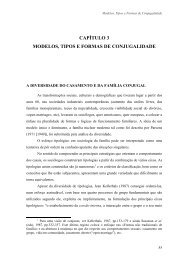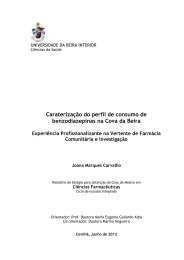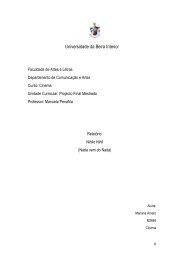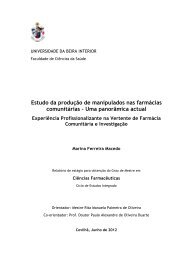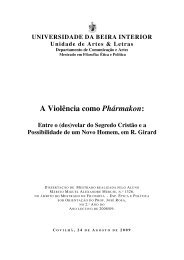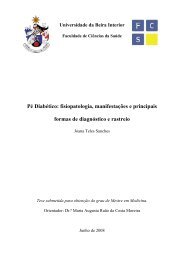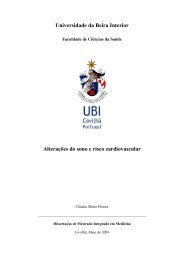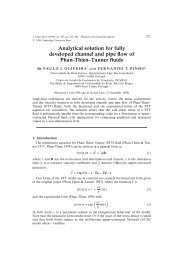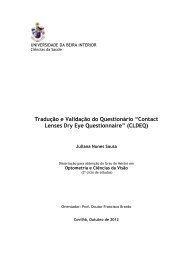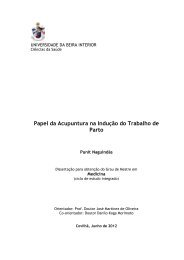Tese_Tânia Vieira.pdf - Ubi Thesis
Tese_Tânia Vieira.pdf - Ubi Thesis
Tese_Tânia Vieira.pdf - Ubi Thesis
Create successful ePaper yourself
Turn your PDF publications into a flip-book with our unique Google optimized e-Paper software.
Chapter III – Results and Discussion<br />
concentration of 2.5 µg/mL (Vertelov et al. 2008). The results of antibacterial activities of AgNPs<br />
using AgNO 3 reduced with hydrazine hydrate against E. coli was 6.74 µg/mL (Guzman et al.<br />
2011). The MIC value of AgNPs with 5 nm against E. coli was 10 μg/mL (Li et al. 2010). The AgNPs<br />
solution prepared by the reduction with glucose at the concentration of 3 μg/mL inhibited E. coli<br />
growth (Lkhagvajav et al. 2011). The different reported values for the antimicrobial activity of<br />
AgNPs can be influenced by the preparation method used as well as by particle size, strain<br />
employed and initial bacterial concentration (Raffi et al. 2008; Lkhagvajav et al. 2011).<br />
Furthermore, other fact that can affect the antibacterial activity of AgNPs is the culture medium<br />
used to perform the MIC assay. The medium used in this study was LB broth, which may be<br />
involved in the precipitation of the released Ag + , in the form of insoluble silver chloride (AgCl).<br />
This form of silver is not available to interact with the bacteria reducing, therefore the<br />
antibacterial capacity (Guzman et al. 2011). Thus, the direct comparison between different<br />
studies is not totally feasible (Ruparelia et al. 2008). However, the MIC value of AgNPs produced<br />
with NaBH 4 was in agreement with the study previously reported by Li and collaborators (Li et al.<br />
2010).<br />
In this study, the AgNPs were also produced with chitosan/dextran nanoparticles, as<br />
stabilizers agents. Therefore, the antibacterial activity of these particles was also evaluated.<br />
The results showed that these nanoparticles presented antibacterial activity (MIC value of 107.1<br />
µg/mL), which was due to the interaction of chitosan amine groups with the bacteria anionic<br />
components, such as LPS and bacteria surface proteins, resulting in the inhibition of bacterial<br />
growth (Kumirska et al. 2011). However, the MIC values determined were higher than those<br />
obtained for the chitosan alone. Such occurrence can be explained by the interactions between<br />
the negatively charged sulfate groups of dextran and the positively charged amine groups of<br />
chitosan, which is responsible for the reduction of the total positive charge available to interact<br />
with bacteria. Still, these results showed that the produced chitosan/dextran nanoparticles can<br />
also contribute to enhance the antibacterial activity of AgNPs.<br />
Previous studies reported that several polymers have been used as stabilizer agents of<br />
AgNPs to prevent their aggregation which is responsible for the loss of the inhibitory effect on<br />
bacterial growth (Levard et al. 2012). In one study performed by Lkhagvajav and colleagues the<br />
antimicrobial activity of AgNPs prepared by using various stabilizers, such as sodium<br />
dodecylsulfate (SDS) and PVP, was also studied and the MIC values against Gram-negative (E.<br />
coli) were determined (10 μg/mL) (Lkhagvajav et al. 2011). Nevertheless, the effect of the<br />
stabilization of AgNPs with polymers could improve, worsen or not even affect the antibacterial<br />
activity of such particles. In a study of Potara and co-workers chitosan was used to promote<br />
stabilization and decreased the aggregation potential, which in turn increased the effective<br />
concentration of particles capable of interact with the bacterial cellular surface (Potara et al.<br />
2011). In that study, the MIC values obtained against S. aureus were around 4 µg/mL. This low<br />
value resulted from the synergic effect between silver and chitosan (Potara et al. 2011).<br />
However, in another study, AgNPs with some capping agents showed to be less bioactive, since<br />
these agents hinder the release of Ag + (Marambio-Jones et al. 2010).<br />
41




